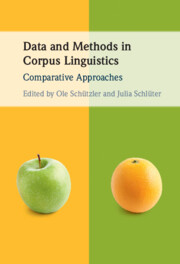Book contents
- Data and Methods in Corpus Linguistics
- Data and Methods in Corpus Linguistics
- Copyright page
- Contents
- Figures
- Tables
- Contributors
- Acknowledgements
- Introduction: Comparative Approaches to Data and Methods in Corpus Linguistics
- Part I Corpus Dimensions and the Viability of Methodological Approaches
- Part II Selection, Calibration and Preparation of Corpus Data
- Part III Perspectives on Multifactorial Methods
- Part IV Applications of Classification-Based Approaches
- Index
- References
Introduction: - Comparative Approaches to Data and Methods in Corpus Linguistics
Published online by Cambridge University Press: 06 May 2022
- Data and Methods in Corpus Linguistics
- Data and Methods in Corpus Linguistics
- Copyright page
- Contents
- Figures
- Tables
- Contributors
- Acknowledgements
- Introduction: Comparative Approaches to Data and Methods in Corpus Linguistics
- Part I Corpus Dimensions and the Viability of Methodological Approaches
- Part II Selection, Calibration and Preparation of Corpus Data
- Part III Perspectives on Multifactorial Methods
- Part IV Applications of Classification-Based Approaches
- Index
- References
Summary
In the Introduction, the editors describe the motivations and aims underlying the publication of the book against the background of the importance of corpus linguistics in current research and the associated methodological diversification. The didactic orientation of the book is outlined, as is its organization into four major parts and the contribution made by each chapter. Going beyond a summary of the contents, the editors voice some reflections on the state of the art in corpus linguistics and desiderata for future research. Finally, recommendations for further reading are listed and provided with comments.
Keywords
- Type
- Chapter
- Information
- Data and Methods in Corpus LinguisticsComparative Approaches, pp. 1 - 14Publisher: Cambridge University PressPrint publication year: 2022



